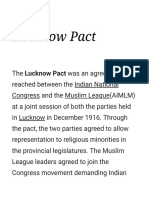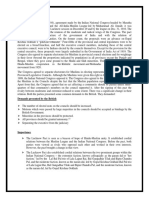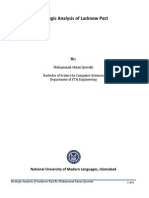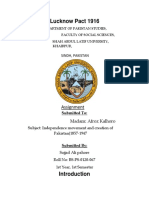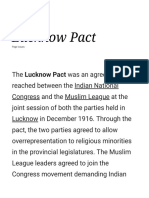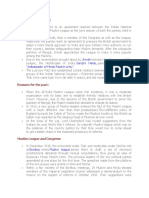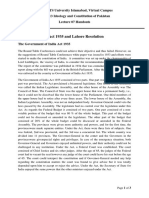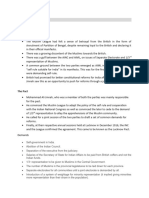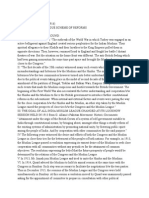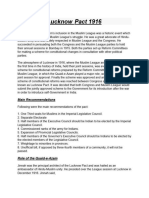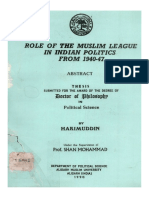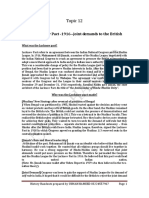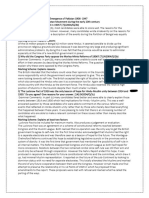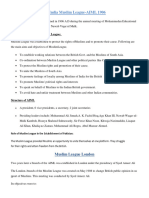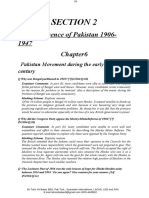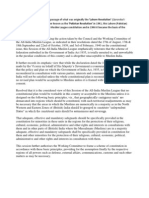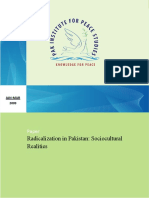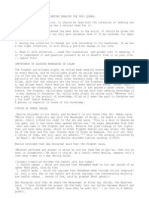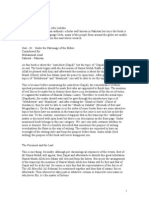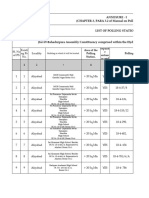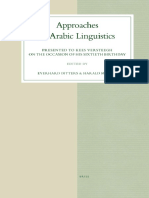The Lucknow Pact of 1916
The Lucknow Pact of 1916
Uploaded by
Maria ZakirCopyright:
Available Formats
The Lucknow Pact of 1916
The Lucknow Pact of 1916
Uploaded by
Maria ZakirOriginal Description:
Copyright
Available Formats
Share this document
Did you find this document useful?
Is this content inappropriate?
Copyright:
Available Formats
The Lucknow Pact of 1916
The Lucknow Pact of 1916
Uploaded by
Maria ZakirCopyright:
Available Formats
SPECIAL ARTICLE
The Lucknow Pact of 1916
A Second Look at the Congress-Muslim League Agreement
Abhay Datar
The Congress-Muslim League Lucknow Pact of 1916 can
easily be considered an important landmark during the
nationalist movement in India. The Congress leaders
agreed to the pact in the expectation that the
executive-legislature relationship in the package of
constitutional reforms would essentially be a
continuation of the Morley-Minto reforms. But the
Montagu-Chelmsford reforms, when announced,
revealed that the nature of this relationship would be
significantly different, leading the Congress leaders to
oppose the pact and to the acceptance of communal
electorates for the Muslims that it entailed, before the
Southborough Committee. The pact also contained
significant omissions and ambiguities which led to
divergent interpretations on crucial provisions.
The author would like to thank the staff at the Gokhale Institute of
Politics and Economics, and Suhas Palshikar for his suggestions
and comments.
Abhay Datar (abhaydatar@hotmail.com) is at the department of politics
and public administration, University of Pune.
Economic & Political Weekly
EPW
march 10, 2012
vol xlviI no 10
he Indian National Congress-All India Muslim League
agreement, popularly known as the Lucknow Pact, can
easily be considered one of the most important events
in the trajectory of the nationalist movement in India. In the
midst of the first world war, in 1916, both organisations presented a joint scheme of constitutional reforms to the colonial
rulers with the expectation that this scheme would be implemented once the war ended. This marked the coming together
of two major political organisations in the country, which
hitherto had displayed a marked hostility to each other.
The significance of the Lucknow Pact lies in the fact that it
was the first time that the Congress reached an agreement
with an organisation which was explicitly a communal one
while the League, founded to counter the Congress claims to
represent the whole of India, reached an agreement with same
organisation. The main feature of the pact was the demand for
an expansion of the representative assemblies, both at the allIndia and provincial levels, and appointment of Indians to the
executive councils of the viceroy and the provincial governors.
But more importantly, the Congress for the first time openly
and explicitly conceded the principle of communal representation by accepting separate electorates for Muslims, something
that it had grudgingly accepted as part of the Morley-Minto
package of constitutional reforms. Moreover, Muslims were
granted a fixed proportion of seats both in the all-India and
the provincial legislatures. Since the pact was announced and
approved at the annual sessions of the two political organisations
held at Lucknow in 1916, it is referred to, in the citys name.
Most of the same Congress leaders who supported the pact
and the principles embodied in it went back on their support
and signalled their opposition soon afterwards in the submissions to the Indian Franchise Committee (known as the Southborough Committee after its chairman, Southborough). This
committee, along with the Committee on the Division of Functions, was appointed to work out the details of the post-war
package of constitutional reforms, known as the MontaguChelmsford reforms after its principal architects the then
secretary of state for India, Edwin Montagu and the viceroy,
Chelmsford. This crucial piece of evidence the proceedings
of the Southborough Committee has been completely
overlooked in the major literature on the Lucknow Pact and
its significance.
A superficial reading of the repudiation of the pact can easily
be ascribed to the bad faith displayed by the Congress leaders
and/or a latent Hindu communalism among them. But, this
65
SPECIAL ARTICLE
paper argues that the pact was signed by the Congress leaders
in the expectation that the post-war reforms would take a
certain shape. However, the reforms as envisaged by the
Montagu-Chelmsford scheme were somewhat different. It is
this change, rather than bad faith or latent communalism, that
led the Congressmen to backpedal on their support to the
Lucknow Pact. Furthermore, this paper also argues that the
pact was a badly drafted agreement, with ambiguities and
omissions in key provisions which ultimately led to contrasting and contradictory interpretations.
In Historiography
The discussion of the pact has overlooked these aspects of the
politics surrounding it. In the colonial period, it was seen as an
important landmark in the development of Indian nationalism
and an instance of political cooperation between the two
important religious communities (Coupland 1944: 47; Report
on Indian Constitutional Reforms 1918: 16; Sitaramayya 1935:
44 and 215). In the post-independence period, this view was
accepted, both officially (Chand 2005: 347) and in scholarly
writings (Hasan 1979: 77). A second more qualified view accepts
the above position but also points that with the pact the
Congress compromised its position as the representative
organisation of all Indians by accepting the representative
character of the League (Prasad 2009: 151). B R Ambedkar had
earlier opined that despite the concessions on the part of the
Hindus, the pact did not produce any rapprochement between
the two communities (Ambedkar 1946: 299).
A third approach takes a completely negative view of the
pact, which is characterised as a surrender to Muslim communalism and separatism (Mehrotra 1979: 227). Furthermore, it has also been argued out that since those Muslim
League leaders were not representative of the Indian Muslim
community, it was merely a deal between the Congress
and the UP Young Party leaders of the Muslim League
(Robinson 2008: 256). The Lucknow Pact has also been cited
to argue that colonial India, at least from 1919 onwards, was a
consociational state (Wilkinson 2000).
Issues Related to the Pact
The ultimate acceptance of the Lucknow Pact was preceded by
long-drawn out negotiations which began in 1915. Till December 1916, the leaders of both the Congress and the Muslim
League were engaged in thrashing out the details of the pact
and at the same time whittling down opposition from within
their respective organisations. All the details of the pact were
not settled by the time both the parties met in Lucknow in December 1916 (Owen 1972; Robinson 2008).
Apart from the long-standing nationalist demands like
allowing Indians to enter the armed services at the higher levels
and the separation of the judicial and executive functions, the
pact essentially dealt with the all-India and provincial-level
legislative assemblies and the nature of the relations between
the executive and the legislature, at these two levels. First and
foremost, it asked for a substantial expansion of the imperial
legislative council and the provincial legislative councils which
66
were to have a majority of elected members. It was agreed that
in each of these councils the Muslims would be granted a fixed
proportion of elective seats, ranging from 15% in the legislative councils of both Madras and the Central Provinces to half
in the Punjab. In the imperial legislative council, the Muslims
were to have one-third of the total elective seats. Muslims
were to elect their representatives through separate electorates and thus did not have the right to vote in the non-Muslim
constituencies. An exception was made in the case of the special interests constituencies where Muslims could vote. All
this was done to guarantee that Muslims would receive a fixed
quantum of representation in any future scheme of constitutional reforms thus helping to overcome their objections to any
such scheme. The bulk of scholarly attention has been focused
on the lengthy negotiations which led to the fixing of the actual proportions of Muslim representation in the councils and
the politics surrounding them (Owen 1972; Robinson 2008).
The lesser known aspect of the pact has been the nature of
relations between the executive and the legislature envisaged
by it. The Morley-Minto reforms of 1908 had led to elected
majorities in some of the provincial councils. At the all-India
level, the executive was the viceroys executive council while
its provincial counterpart was the governors executive council
which existed in only the three presidencies, Bombay, Bengal
and Madras. These executive councils were in no significant
measure responsible to their respective legislatures. The pact
demanded that all provinces were to have executive councils
and that at least half the members of these councils would be
Indians, who in turn would be elected by the elected members
of the legislative councils. A similar demand was made for the
viceroys executive council. But though half the executive was
elected by the legislature, the executive as a whole was not to
be responsible to the legislature. The elected half of the executive was irremovable by the legislature. But since crucial matters like the budget were to depend upon the approval of the
legislature, this arrangement guaranteed a constitutional
deadlock. This was in sum the basic nature of executive-legislature relations that the Congress expected from and asked for
in any scheme of post-war constitutional reforms. Thus what
the Lucknow Pact asked for was a significantly expanded
version of the Morley-Minto reforms package.
The adherents of the pact tried to explain away this inherent
disconnect between the executive and the legislature at the
annual Congress session at Calcutta in 1917. Veteran Congressmen Surendranath Banerjea and B G Tilak pointed out that
though the legislature could not dismiss the executive, such an
arrangement would practically mean that the former controlled the latter. Only Bipin Chandra Pal was honest enough to
say that this arrangement would lead to constant deadlock,
which was what he wanted in any case (Report of the XXXII
Session of The Indian National Congress 1918: 94-101). An earlier pamphlet, written by V S Srinivasa Sastri, tried to square
this circle by pointing out that the executive could easily control the legislature through patronage and that an irremovable
executive was necessary given Indian conditions (Sastri 1917:
31 and 38). This understanding of the executive-legislature
march 10, 2012
vol xlviI no 10
EPW
Economic & Political Weekly
SPECIAL ARTICLE
relations on part of the Congress leaders was not new. Gopal
Krishna Gokhales earlier draft scheme of post-war constitutional
reforms as well as the famous memorandum of the nineteen,
an outline of future reforms submitted by the majority of the
non-official members of the imperial legislative council in
1915, envisaged a similar pattern of executive-legislature relations (Karve and Ambekar 1966: 315; Sitaramayya 1935: i-vi).
The Colonial Calculus
What the colonial rulers were planning to deliver was something different. On 20 August 1917, Edwin Montagu announced
in the House of Commons that the policy of the government
towards India in the future would be in the direction of gradual development of self-governing institutions with a view to
the progressive realisation of responsible government in
India (Report on Indian Constitutional Reforms 1918: 1). The
phrase responsible government obviously did not, and no
longer could mean, that the Government of India would continue
to be responsible only to the imperial government in London,
or that the provincial governments would be responsible only
to the Government of India. It naturally implied that the
government would be responsible, in what measure it was not
defined, to the people through their elected representatives in
the legislative assemblies. One study of the process of reforms
has interpreted this phrase even more expansively to mean
government by ministers who commanded a majority in the
legislature (Robb 1986: 77). Whatever might be the interpretation of this key phrase, one aspect was clear. The pattern
of relations between the executive and the legislature was
about to change, albeit only in the provinces and not at the
all-India level.
However, it was equally obvious that the British were not
going to hand over power to predominantly elected legislatures with an Indian majority. Yet the executive had to be
made responsible in some measure to the elected assemblies,
whose size and the proportion of elected members in which
was going to be increased in any case. The solution that
emerged was dyarchy, which had been discussed in detail in
the Montagu-Chelmsford Report (Report on Indian Constitutional Reforms 1918: 140). This meant that the powers allotted
to the provinces would be divided into two parts known as
transferred subjects and reserved subjects. The former
would be handed over to ministers appointed from amongst
the elected members of the legislatures. The latter would continue to be handled by members of the governors executive
councils who would continue to be appointed by the governor
and the legislature was to have no part in their appointment.
Though the Montagu-Chelmsford Report claimed that the
ministers would be responsible to their constituents and not to
the legislature (ibid: 142), this was clearly an illogical and illusory position, contrary to all practice of parliamentary government. It was clear that the ministers, if they were to continue
in office, must enjoy the confidence of the assembly. The Joint
Parliamentary Committee of the Government of India Bill,
1919, conceded this and agreed that the ministers should enjoy
the confidence of the house (Curtis 1920: 550). This idea of
Economic & Political Weekly
EPW
march 10, 2012
vol xlviI no 10
dyarchy came from a realisation that mere expansion of the
legislative councils, as had happened in the Morley-Minto
reforms was not adequate. Some element of responsibility of
the executive towards the legislature had to be incorporated
to make the constitutional reforms a practical proposition
(Robb 1986: 54-85). In fact the Montagu-Chelmsford Report
had criticised the Lucknow Pact for not making any provision
for connecting the two branches of government (Report on
Indian Constitutional Reforms, 1918: 107-09 and 112).
What was the exact significance of these measures for the
nationalist movement in India? For the first time, a significant
chunk of power was now available to Indians. They could now
aspire to become ministers who would probably control significant nation-building departments like education, agriculture, etc. They could be legislators who could actively influence
decision-making by making and unmaking ministers. This
was certainly different from the earlier versions of councils
where for a long time all that elected Indian members could do
was to make well-reasoned and long speeches which could be
easily disregarded by their colonial masters. Power was now
within the reach of nationalist politicians who could build
coalitions to command majorities in the provincial councils.
The crux of the reforms was now the changed nature of the
executive-legislature relations and not the earlier issues of
communal electorates and their extent. The realisation that,
not just the situation but the very structure of politics, had
changed, made many of the Congress leaders all of the
Hindus in particular to change their positions regarding the
Lucknow Pact, about which most of them had earlier displayed
conspicuous enthusiasm.
Changed Opinions about the Pact
The seven member Southborough Committee had three Indian
members, Surendranath Banerjea, V S Srinivasa Sastri and
Sahibzada Aftab Ahmad Khan. The first two had been present at
the Lucknow session of the Congress and Banerjea had spoken
on the resolution regarding the pact. The committee toured India
from November 1918 till February 1919 and met provincial
governors and their executive councillors, and received written
submissions and examined official and non-official witnesses.
The change in the position on part of the Congress leaders
regarding the Lucknow Pact and the communal electorates it
entailed came to the fore in the proceedings of the committee.
While accepting the pact, most Congress leaders either objected to the principle of communal electorates or the quantum of political representation granted to the Muslims.
The United Provinces Congress Committee, whose representatives Pandit Madan Mohan Malaviya and Pandit Motilal
Nehru, appeared before the committee, did support the pact,
but also fact proposed a scheme of proportional representation
as an alternative to communal electorates. Malaviya also proposed a scheme by which constituencies with a predominant
Muslim electorate would be earmarked for Muslims, a scheme
of joint electorates with reservations (The Reforms Committee
(Franchise), Evidence Taken before the Reforms Committee
(Franchise), Vol I, 1919: 111). The Bengal Congress Committees
67
SPECIAL ARTICLE
representative, B K Lahiri, stated that while the committee
accepted the pact, it preferred reserved seats in joint electorates (ibid, Vol II, 1918: 411-13).
R N Mudholkar and Ambica Charan Mazumdar, two former
Congress presidents, declared their opposition to communal
electorates and thus to the Lucknow Pact. The latter had in
fact presided over the Congress session at Lucknow where the
pact had been approved. Mudholkar declared that he was personally opposed to communal electorates but had accepted it
to secure the cooperation of all communities (ibid, Vol I: 283).
Mazumdar declared that he personally preferred reserved
seats in joint electorates but supported the Lucknow Pact since
he had been a party to it (ibid, Vol II: 434). Disguised opposition
came from the Congress leaders of the Bombay Presidency. The
Bombay National Union supported the pact but its representative, D D Sathaye, a close associate of Tilak, claimed that he
was personally opposed to communal electorates and that he
was supporting the pact only because this compromise had been
arrived at by Tilak. Vitthalbhai Patel regarded the quantum of
representation given to Muslims in the Bombay Presidency
inequitable but added that unless both parties agreed to reconsider the issue, this was to stand. N C Kelkar, one of Tilaks
closest associates, declared that he had supported the pact in
a spirit of resignation and that he regarded the proportion of
representation given to Muslims in the Bombay Presidency as
excessive. Moderate leaders like R P Paranjpye and N M Joshi
also thought the quantum of Muslim representation in Bombay
as excessive (ibid, Vol II: 719-20, 740, 764-68, 761 and 774).
Interestingly, opposition to the principle of communal representation came from a Congress Muslim leader from Bihar,
Mazharul Haque. He vehemently repudiated communal electorates and added that he had accepted the pact only because
he had been forced to do so (The Reforms Committee (Franchise),
Evidence Taken before the Reforms Committee (Franchise), Vol I,
1919: 172). Some other Muslim witnesses also opposed or expressed serious reservations about communal electorates and
thus to the Lucknow Pact. Yet despite all this, the Congress
session held in 1918 at Delhi reiterated its resolutions passed at
the Bombay special session held in mid-1918, one which categorically stated that the quantum of representation for
Muslims in the Lucknow Pact be adhered to (Report of the
Thirty-third Session of the Indian National Congress 1919).
The fact that the pact was a badly drafted agreement also
came to the fore during the proceedings of the committee. The
pact had listed the proportion of seats out of the total Indian
elected members that were to be assigned to the Muslims
in the Imperial and in each of the provincial councils. The
Montagu-Chelmsford reforms, like the earlier Morley-Minto
reforms, also envisaged elective representation for important
interests like the landlords, the Indian commercial community
and universities in the enlarged councils. It was clear that
Indians would be elected from these special constituencies.
But the Lucknow Pact did not make it explicit whether these
constituencies were to be excluded or included in the total
number of elective seats in calculating the actual number of
seats for the Muslims. The Congress leaders like A Rangaswamy
68
Iyengar of Madras and H N Apte, the well-known Marathi
novelist from Pune, both of them who had been present at
Lucknow, when quizzed on this point claimed that they did
not know how the Lucknow Pact had planned to deal with this
(ibid, Vol II: 614 and 763). As a consequence the detailed
schemes presented by Congress leaders for their own provinces
went in all sorts of directions. Some like the Bihar Provincial
Association even included seats which would have been won
by Europeans, while others like Kelkar excluded the special
constituencies.
The Lucknow Pact also had nothing to say about Assam, a
point stressed much later by Ambedkar (Ambedkar 1946: 244).
This meant that the proportion of representation for Muslims
in Assam had to be worked out separately. Another problematic instance was that of Sind, a Muslim majority area of the
Bombay Presidency, about which the pact had nothing to say.
The Muslims were a minority in the Bombay Presidency as a
whole. Since it had granted separate electorates to Muslims
even in provinces like Punjab and Bengal where they were in a
majority, it might have been assumed that the same was applicable to Sind as well. But a scheme of political representation
for the Bombay provincial council submitted to Montagu and
Chelmsford during their tour of India by leading nationalists
of the Presidency provided, among other measures, for communal electorates for Hindus in Sind.1 The Bombay governments proposals to the Franchise Committee also envisaged
communal electorates for Hindus in Sind (Report of the Franchise Committee, 1918-19, 1919: 137-39).
These suggestions were strongly opposed by M A Jinnah
who originally hailed from Karachi, and Ghulam Hussain
Hidayatullah from Sind while appearing separately before the
committee. Jinnah was vehement in his opposition to separate
electorates for the Hindus of Sind and argued that the Bombay
governments proposals in this regard were in fact contrary to
the Lucknow Pact. While Hidayatullah supported separate
electorates for Hindus on grounds of fairness, he was opposed
to denying separate electorates to Muslims of Sind on grounds
that they were in a majority. He claimed this was an illusionary majority since the Muslims were illiterate and backward
as also influenced by the Hindus (The Reforms Committee
(Franchise), Evidence Taken before the Reforms Committee
(Franchise), Vol II, 1919: 721 and 792). Clearly, the omission of
Sind was a major lacuna.
Volte-Face Explained
This unexpected and startling volte-face of many of the Congress
leaders over the Lucknow Pact requires an explanation. Prima
facie, one could accuse them of having agreed to the pact in
bad faith, an accusation made by the South Indian Liberal
Federation, the political vehicle of the Madras non-brahmins
which claimed that the pact was a compromise based on tactical
considerations and on the theory of united front and that
individual Congressmen were keen to get rid of the communal
electorates (ibid, Vol II, 675-76). But if the Congress leaders
signed the pact with the League with the intention of repudiating it later, this would have required a conspiracy on a large
march 10, 2012
vol xlviI no 10
EPW
Economic & Political Weekly
SPECIAL ARTICLE
scale and such intentions could hardly have been kept a secret.
While it is true that many Congressmen were opposed to communal electorates as such, the very fact that they accepted the
pact shows that they had accepted them, albeit grudgingly.
Prior to the Montagu-Chelmsford Report, there is no evidence to
suggest that the Congress leaders planned to repudiate the pact.
A latent Hindu communalism can be a competing explanation. It is true that there were many Congressmen who could
be legitimately described as Hindu communalist or had
sympathies in that direction and that many Hindu Congress
leaders had to be coaxed of the need to approve of the pact
(Owen 1972; Robinson 2008). Equally true is that fact that
there was a considerable overlap between the leaders of the
Congress and the newly emergent Hindu Mahasabha (Gordon
1975: 145-203). But these leaders could have easily maintained
their opposition to the pact instead of declaring it before the
Southborough Committee. Indeed these leaders did not signal
their opposition prior to the Montagu-Chelmsford Report.
The old dividing line between extremists and moderates also
cannot explain the opposition.
If these two possible explanations are not persuasive, then
the only other plausible explanation is structural. The Congress
Note
1 Note justifying and supplementing the Congress-League Scheme of Reform with An
Introductory Representation To His Excellency, the Right Honourable Baron Chelmsford,
The Viceroy and Governor General of India
and The Right Honourable Edwin Samuel
Montagu, The Secretary of State for India
1917: 47-49.
References
Ambedkar, Dr B R (1946(1967)): Pakistan Or The
Partition of India (Bombay: Thackers & Co).
Chand, Tara (2005(1972)): History of the Freedom
Movement in India, Volume Three (New Delhi:
Publications Divisions, Government of India).
had agreed to the pact in the expectation that the long-awaited
post-war constitutional reforms would be an extension of the
Morley-Minto reforms. This meant that there was no real
chance of gaining power. Thus with no substantial power to be
shared, it was easy for the Congress leaders to make concessions by accepting the demand for communal electorates and
guaranteed representation for the Muslims. The Muslims
were merely required to present a united front. Instead, the
Montagu-Chelmsford Report came up with a completely
different reforms package. Some power was now within the
grasp of those who could command majorities in the new provincial legislatures. In the Hindu majority provinces, the
Hindu Congressmen could easily hope to secure a majority
without the Muslims and thus there was no longer any incentive to secure their cooperation. It is this realisation that
power could be had without the Muslims that made them
oppose the Lucknow Pact and the communal electorates for
the Muslims that it entailed. The Nehru Report of the 1920s is
regarded as the turning point when the Congress finally
turned away from communal electorates. But the groundwork
for this turning had already been laid in the proceedings of the
Southborough Committee.
Coupland, Reginald (1944): The Indian Problem:
Report on the Constitutional Problem in India
(New York: Oxford University Press).
Curtis, Lionel (1920): Papers Relating to the Application of the Principle of Dyarchy to the Government of India (Oxford: Clarendon Press).
Gordon, Richard (1975): The Hindu Mahasabha
and the Indian National Congress, 1915 to
1926, Modern Asian Studies, 9 (2), 143-205.
Hasan, Mushirul (1979): Nationalism and Communal
Politics in India (New Delhi: Manohar).
Karve, D G and D V Ambekar, ed. (1966): Speeches
and Writings of Gopal Krishna Gokhale, Volume
Two: Political (Bombay: Asia Publishing House).
Mehrotra, S R (1979): Towards Indias Freedom and
Partition (New Delhi: Vikas Publishing House).
Owen, Hugh F (1972): Negotiating the Lucknow
Pact, Journal of Asian Studies, Vol 31 (3), 561-87.
Prasad, Bimal (2009): Pathway to Indias Partition:
A Nation within a Nation (Nw Delhi: Manohar).
Robb, Peter (1986): The Government of India and
Reform, Policies Towards Politics and the Constitution, 1916-1921 (New Delhi: Heritage Publishers).
Robinson, Francis (2008 (1974)): Separatism among
Indian Muslims: The Politics of the United
Provinces Muslims 1860-1923 (Cambridge,
Cambridge University Press).
Sastri, V S Srinivasa (1917): The Congress-League
Scheme: An Exposition (Poona: Servants of
India Society).
Sitaramayya, B Pattabhi (1935): History of the Indian National Congress, 1885-1935 (Allahabad:
Indian National Congress).
Wilkinson, Steven Ian (2000): India, Consociational
Theory, and Ethnic Violence, Asian Survey,
40 (5), 767-91.
SAMEEKSHA TRUST BOOKS
China after 1978: Craters on the Moon
The breathtakingly rapid economic growth in China since 1978 has attracted world-wide attention. But the condition of more than 350 million workers is abysmal,
especially that of the migrants among them. Why do the migrants put up with so much hardship in the urban factories? Has post-reform China forsaken the
earlier goal of socialist equality? What has been the contribution of rural industries to regional development, alleviation of poverty and spatial inequality, and
in relieving the grim employment situation? How has the meltdown in the global economy in the second half of 2008 affected the domestic economy? What
of the current leaderships call for a harmonious society? Does it signal an important course correction?
A collection of essays from the Economic & Political Weekly seeks to find tentative answers to these questions, and more.
Pp viii + 318
ISBN 978-81-250-3953-2
2010
Rs 350
Available from
Orient Blackswan Pvt Ltd
www.orientblackswan.com
Mumbai Chennai New Delhi Kolkata Bangalore Bhubaneshwar Ernakulam Guwahati Jaipur Lucknow Patna Chandigarh Hyderabad
Contact: info@orientblackswan.com
Economic & Political Weekly
EPW
march 10, 2012
vol xlviI no 10
69
You might also like
- Lucknow PactDocument21 pagesLucknow Pactbhojia71% (7)
- AS1412-Mabadi-ul - Fiqhiyyah (SYKRH)Document3 pagesAS1412-Mabadi-ul - Fiqhiyyah (SYKRH)Abdul GhaffarNo ratings yet
- The Lucknow Pact of 1916 A Second Look ADocument5 pagesThe Lucknow Pact of 1916 A Second Look AMuhazzam KhanNo ratings yet
- Lucknow Pact - Wikipedia PDFDocument11 pagesLucknow Pact - Wikipedia PDFAdnan haiderNo ratings yet
- Lucknow Pact - WikipediaDocument8 pagesLucknow Pact - WikipediaHamza AfzalNo ratings yet
- Lucknow PactDocument7 pagesLucknow PactM Uzair khan JadoonNo ratings yet
- NCERT Notes: The Lucknow Pact, 1916Document2 pagesNCERT Notes: The Lucknow Pact, 1916Marianinu antonyNo ratings yet
- Muslim LeagueDocument9 pagesMuslim LeagueInoxent DivilNo ratings yet
- Luckow Pact 1916: Aiml and Inc Pact: Circumstances Leading To The Lucknow Pact 1916Document2 pagesLuckow Pact 1916: Aiml and Inc Pact: Circumstances Leading To The Lucknow Pact 1916Mudassar ManzoorNo ratings yet
- Strategic Analysis of Lacknow PactDocument6 pagesStrategic Analysis of Lacknow PactAdnanRiazNo ratings yet
- Lucknow Pact 1916: AssignmentDocument3 pagesLucknow Pact 1916: AssignmentKamran Ali AbbasiNo ratings yet
- Lukhnow Pact - History PakDocument3 pagesLukhnow Pact - History PakArslan ZaibNo ratings yet
- Background To Lucknow PactDocument2 pagesBackground To Lucknow Pactghazi membersNo ratings yet
- Lucknow PactDocument4 pagesLucknow PactKhalil AhmedNo ratings yet
- HUM113 Handouts Lecture05Document4 pagesHUM113 Handouts Lecture05alinoornabeel110No ratings yet
- Lucknow Pact - WikipediaDocument11 pagesLucknow Pact - WikipediaNoman KhanNo ratings yet
- Lucknow PactDocument4 pagesLucknow PactTushar Sinha63% (8)
- Pre Lucknow Pact 1916Document7 pagesPre Lucknow Pact 1916AS IFNo ratings yet
- Lecture05 MINT MORLEY and LUCKNOWDocument4 pagesLecture05 MINT MORLEY and LUCKNOWbaseer khanNo ratings yet
- Lucknow Pact - WikipediaDocument8 pagesLucknow Pact - Wikipediafatima vohraNo ratings yet
- Lucknaw Pact 1916Document5 pagesLucknaw Pact 1916Mustakin KutubNo ratings yet
- The Lucknow PactDocument3 pagesThe Lucknow PactResearcher QauNo ratings yet
- Assignment: Lucknow PactDocument5 pagesAssignment: Lucknow PactSibghaNo ratings yet
- Lucknow Pact1Document3 pagesLucknow Pact1Qaisar MahmoodNo ratings yet
- Lucknow PactDocument3 pagesLucknow PactHaleema GulNo ratings yet
- LakhnawDocument2 pagesLakhnawMahmudur Rahman27No ratings yet
- The Lucknow Pact 1916Document11 pagesThe Lucknow Pact 1916House of knowledgeNo ratings yet
- Lecture 2Document23 pagesLecture 2MH SakibNo ratings yet
- Election Week Hometask Muhammad Musa2Document4 pagesElection Week Hometask Muhammad Musa2Muhammad Musa HaiderNo ratings yet
- Lucknow PactDocument4 pagesLucknow PactIzhar HussainNo ratings yet
- Lecture 2Document4 pagesLecture 2MH SakibNo ratings yet
- HUM113 Handouts Lecture07Document3 pagesHUM113 Handouts Lecture07Evil MadNo ratings yet
- Lucknow PactDocument2 pagesLucknow PactSohaibNo ratings yet
- A Lucknow PactLecture 11 Week 6thDocument3 pagesA Lucknow PactLecture 11 Week 6thBsee Electronics100% (5)
- Lucknow PactDocument5 pagesLucknow PactMuhammad Ateeq100% (1)
- 5 LucknowPactDocument3 pages5 LucknowPactcsscabinet460No ratings yet
- The Lahore Resolution of 1940: The Road To Religious PartitionDocument20 pagesThe Lahore Resolution of 1940: The Road To Religious PartitionNihal Al RafiNo ratings yet
- Role of The Muslim League in Indian Politics From 1940-47: Bottor of $L) Iios Opi - PDocument356 pagesRole of The Muslim League in Indian Politics From 1940-47: Bottor of $L) Iios Opi - PSaNia KhanNo ratings yet
- HIST TOPIC 12 The Lucknow Pact 1916 Joint Demands To The British PDFDocument3 pagesHIST TOPIC 12 The Lucknow Pact 1916 Joint Demands To The British PDFabubakarNo ratings yet
- Cabinet Mission Plan From A Muslim League PerspectiveDocument8 pagesCabinet Mission Plan From A Muslim League PerspectiveKishorerajSelvarajNo ratings yet
- The Lucknow Pact 1916 UpdatedDocument6 pagesThe Lucknow Pact 1916 Updatedmaria sabirNo ratings yet
- The Lucknow Pact (1916)Document1 pageThe Lucknow Pact (1916)sushmaNo ratings yet
- Freedom Movement 1937 To 1947Document27 pagesFreedom Movement 1937 To 1947Pervaiz AliNo ratings yet
- Constitutional Assembly DebatesDocument4 pagesConstitutional Assembly DebatesmNo ratings yet
- Lucknow Pact, India Act 1919, Khilafat MovementDocument10 pagesLucknow Pact, India Act 1919, Khilafat Movementjaz hoodNo ratings yet
- The Hindu Code Bill Creating The Modern Hindu Legal SubjectDocument34 pagesThe Hindu Code Bill Creating The Modern Hindu Legal SubjectSanskriti RazdanNo ratings yet
- Lucknow Pact & The Morley-Minto Reforms.: BY Noor Fatima 9-T HistoryDocument20 pagesLucknow Pact & The Morley-Minto Reforms.: BY Noor Fatima 9-T HistoryAwais KhanNo ratings yet
- CH 6 TPPDocument12 pagesCH 6 TPPMuaz MalikNo ratings yet
- ??04 NotesDocument4 pages??04 NotesneelamfazalpkNo ratings yet
- Lucknow PactDocument9 pagesLucknow Pactstd15-446No ratings yet
- Timeline Questions Notes and Solved Past Papers 2023-24Document46 pagesTimeline Questions Notes and Solved Past Papers 2023-24techno gmaezNo ratings yet
- History Papers 2Document42 pagesHistory Papers 2Mariyam AjazNo ratings yet
- Lahore Resolution (1940)Document3 pagesLahore Resolution (1940)eva.evax6001No ratings yet
- Constitution of India As A Reflection of The Ideals of The Indian National MovementDocument3 pagesConstitution of India As A Reflection of The Ideals of The Indian National MovementYasi NabamNo ratings yet
- March 23 Commemorates The Passage of What Was Originally TheDocument1 pageMarch 23 Commemorates The Passage of What Was Originally TheQuratulain AshfaqNo ratings yet
- Objective of The StudyDocument11 pagesObjective of The StudyBhanuNo ratings yet
- Voices in the Wilderness: Critiquing Indian Constituent Assembly DebatesFrom EverandVoices in the Wilderness: Critiquing Indian Constituent Assembly DebatesNo ratings yet
- ABCDocument78 pagesABCMaria ZakirNo ratings yet
- 311 Session4 KristenCookiesDocument31 pages311 Session4 KristenCookiesMaria ZakirNo ratings yet
- ExerciseQuestions SolutionDocument11 pagesExerciseQuestions SolutionMaria Zakir100% (2)
- Operations Strategy: Multiple ChoiceDocument6 pagesOperations Strategy: Multiple ChoiceMaria Zakir100% (3)
- Pakistan MovementDocument37 pagesPakistan MovementMaria ZakirNo ratings yet
- Schiffman cb11 Ippt01Document27 pagesSchiffman cb11 Ippt01Maria ZakirNo ratings yet
- Lecture Notes The Nature of Strategic Management: Chapter OutlineDocument18 pagesLecture Notes The Nature of Strategic Management: Chapter OutlineMaria ZakirNo ratings yet
- Introduction To Industrial MarketingDocument4 pagesIntroduction To Industrial MarketingMaria ZakirNo ratings yet
- Introduction To Business-to-Business Marketing: Vitale A ND Gig LieranoDocument18 pagesIntroduction To Business-to-Business Marketing: Vitale A ND Gig LieranoMaria ZakirNo ratings yet
- Food Shortage: Supply VS DemandDocument19 pagesFood Shortage: Supply VS DemandMaria ZakirNo ratings yet
- 01 NetflixDocument13 pages01 NetflixMaria ZakirNo ratings yet
- Chapter 16Document13 pagesChapter 16Maria ZakirNo ratings yet
- Chapter 6 Strategic Research: Advertising & IMC: Principles and Practice, 9e (Moriarty)Document40 pagesChapter 6 Strategic Research: Advertising & IMC: Principles and Practice, 9e (Moriarty)Maria Zakir100% (2)
- Chapter Five: The Financial Statements of Banks and Their Principal CompetitorsDocument30 pagesChapter Five: The Financial Statements of Banks and Their Principal CompetitorsMaria ZakirNo ratings yet
- CV Mohd Khairy KamarudinDocument3 pagesCV Mohd Khairy KamarudinLeela BelLaNo ratings yet
- Six Fasts of Shawwal Sample PagesDocument5 pagesSix Fasts of Shawwal Sample PagesLingua ArabicNo ratings yet
- The Plight of MankindDocument3 pagesThe Plight of MankindMohammed Al-AmraniNo ratings yet
- Data Peserta UP (Responses)Document17 pagesData Peserta UP (Responses)Alhie PrasetyoNo ratings yet
- Jadwal Hafalan Maret 2023 Pips UinmalangDocument13 pagesJadwal Hafalan Maret 2023 Pips UinmalangRh.Syafrila Arum DivaNo ratings yet
- Islamic Research Institute, International Islamic University, IslamabadDocument12 pagesIslamic Research Institute, International Islamic University, IslamabadMatthieu DevianNo ratings yet
- Muslim Town (Script)Document4 pagesMuslim Town (Script)experiencequiapoNo ratings yet
- Karl-Heinz Ohlig, Gerd-R Puin (Ed.) - The Hidden Origins of Islam. New Research Into Its Early History - 2009 PDFDocument403 pagesKarl-Heinz Ohlig, Gerd-R Puin (Ed.) - The Hidden Origins of Islam. New Research Into Its Early History - 2009 PDFIsmael632395% (21)
- Fiqh 'Amal Jama'ieDocument12 pagesFiqh 'Amal Jama'ieazmibhrNo ratings yet
- PunjabDocument5 pagesPunjabdhamalkomaltNo ratings yet
- Radicalization in Pakistan SocioculturalDocument18 pagesRadicalization in Pakistan SocioculturalShahbazNo ratings yet
- Manual Dicq 7aedicaoDocument57 pagesManual Dicq 7aedicaoEqui ProanáliseNo ratings yet
- Arabic Notes For CssDocument42 pagesArabic Notes For CssZeeshan AliNo ratings yet
- The Sexual Slavery of Yazidis by ISISDocument2 pagesThe Sexual Slavery of Yazidis by ISISWaritsa YolandaNo ratings yet
- Tafsir Notes, Surah IkhlasDocument3 pagesTafsir Notes, Surah IkhlasalimafzalNo ratings yet
- Killing Fields of ABSDF Under DR Naing Aung-EnglDocument31 pagesKilling Fields of ABSDF Under DR Naing Aung-EnglPugh JuttaNo ratings yet
- Why Do Priests Enters IslamDocument34 pagesWhy Do Priests Enters IslamzahreinNo ratings yet
- Gandhi - Collected Works Vol 93Document423 pagesGandhi - Collected Works Vol 93Nrusimha ( नृसिंह )No ratings yet
- DajjalDocument46 pagesDajjalRahat AliNo ratings yet
- Ecological Resilient Corridors: Redefining Urban Landscape Under Flyover Into A Meaningful Socio-Cultural PlaceDocument22 pagesEcological Resilient Corridors: Redefining Urban Landscape Under Flyover Into A Meaningful Socio-Cultural PlaceRifah MashiatNo ratings yet
- 2020 - SENARAI MURID - 13jan2020Document24 pages2020 - SENARAI MURID - 13jan2020Rabiatul DzubaidiNo ratings yet
- New Sarfaraaz FileDocument39 pagesNew Sarfaraaz Filepavithrachander369No ratings yet
- The Net Present Value of Mudharabah And: Musharakah ModelsDocument22 pagesThe Net Present Value of Mudharabah And: Musharakah ModelsmohsinbilalNo ratings yet
- Approach To Arabic Linguistics Diglosie 403 PDFDocument794 pagesApproach To Arabic Linguistics Diglosie 403 PDFNoemiKissNo ratings yet
- Daftar Peserta Cek Fisik Ijon 2023Document5 pagesDaftar Peserta Cek Fisik Ijon 2023Bual BualNo ratings yet
- Monwealth MSO141019Document18 pagesMonwealth MSO141019Fazlul Karim AkashNo ratings yet
- Importance of AkhlaqDocument3 pagesImportance of AkhlaqmdedNo ratings yet
- The Taj Mahal Is Tejo - Mahalaya: A Shiva TempleDocument14 pagesThe Taj Mahal Is Tejo - Mahalaya: A Shiva TempleSonal SoniNo ratings yet
- Answer Key-Grade 6 Revision Worksheet 3rd Term2023Document7 pagesAnswer Key-Grade 6 Revision Worksheet 3rd Term2023Muhammad Ahmed100% (1)




